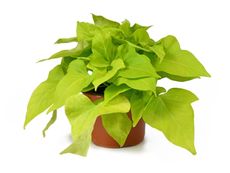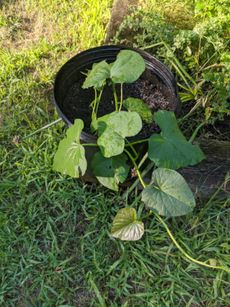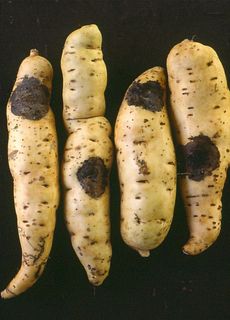Sweet Potatoes
Growing sweet potatoes taps you into a nourishing treat for bakes, roasts and pies. A long, warm growing season is all you need to grow your own sweet and creamy tubers. Our expert tips explain how to plant, protect and care for your sweet potato plants to guarantee happy harvests.
-
Sweet Potato Soft Rot Treatment: Controlling Bacterial Soft Rot Of Sweet Potato Plants
Also referred to as sweet potato bacterial stem and root rot, bacterial sweet potato rot is favored by high temperatures combined with high humidity. The following article contains information on identifying the symptoms of sweet potato soft rot and how its control.
By Amy Grant
-
Sweet Potato Internal Cork : What Is Sweet Potato Feathery Mottle Virus
Speckled leaves with purplish borders may be pretty but can be the sign of a serious disease of sweet potatoes a?? feathery mottle virus. The disease is transmitted by tiny insect vectors and can be difficult to diagnose and control. Learn more here.
By Bonnie L. Grant
-

What Is A Sweet Potato Slip: How To Get Sweet Potato Slips For Planting
What is a sweet potato slip and how do you get sweet potato slips? If you’re interested in sweet potato slip growing, click here.
By Amy Grant
-

Winterizing A Sweet Potato Vine: Overwintering Ornamental Sweet Potatoes
There are three different methods for overwintering sweet potato plants. Which way you save your sweet potato vines over winter depends upon how much work you want to do and how cold your region becomes during winter. Click here to learn more.
By Bonnie L. Grant
-

Ornamental Sweet Potato Plants - How to Grow Them
Not meant for eating, ornamental sweet potato plants can add a dramatic touch to your patio or indoor houseplant collection.
By Gardening Know How
-

Companion Planting With Yams – What To Plant Next To Yams
You may not know it, but if you've ever had sweet potatoes, you have had yams. Yam companion plants must share the same growing conditions as the tuber and have the ability to repel certain pests. Learn more in this article.
By Bonnie L. Grant
-

Sweet Potato Rotting After Harvest – What Causes Sweet Potato Storage Rots
A number of bacterial and fungal pathogens cause storage rot of sweet potatoes. The following article contains information on diseases that can result in sweet potatoes rotting after harvest and how to control sweet potato rot during storage.
By Amy Grant
-

Sweet Potato Plant Starts: How And When To Start Sweet Potato Slips
Unlike other potatoes, sweet potatoes are grown from slips. You can order sweet potato plant starts but it's very simple to sprout your own. Learn more about starting sweet potato slips in this article.
By Anne Baley
-

Why Are My Sweet Potatoes Cracking: Reasons For Sweet Potato Growth Cracks
For the first months, your crop of sweet potatoes looks picture perfect, then one day you see cracks in a sweet potato. As time passes, you see other sweet potato growth cracks and you wonder: why are my sweet potatoes cracking? Click here to find out.
By Teo Spengler
-

Sweet Potato Vine Division: Tips On Dividing Sweet Potato Vines
Splitting sweet potatoes is one way to create new vines with very little investment of time or money. Dividing sweet potato vines to propagate new vines is easy, as the vines grow from fleshy underground tubers. Click here for tips on sweet potato vine division.
By Mary H. Dyer
-

Sweet Potato With White Leaves: Ornamental Sweet Potatoes With Bumpy Leaves
Sweet potato vines are very hardy and suffer from few problems, but occasionally white spots on sweet potato foliage appear. Read this article to learn how to cure this problem and what causes white bumps in the first place.
By Kristi Waterworth
-

Yellow Sweet Potato Leaves: Why Do Sweet Potato Leaves Turn Yellow
Sweet potatoes are incredibly high in vitamin A, are a great source of beta carotene and antioxidants. Even so, this "super food" has its share of growing problems such as yellow leaves on sweet potatoes. Learn why sweet potato leaves turn yellow in this article.
By Amy Grant
-

Growing Sweet Potatoes Vertically: Planting Sweet Potatoes On A Trellis
For gardeners with limited space, growing sweet potatoes on a trellis may be the only way to include this tasty tuber among their homegrown vegetables. As an added bonus, these vines make attractive patio plants. Learn about vertically growing sweet potatoes here.
By Laura Miller
-

Sweet Potato Black Rot : How To Manage Sweet Potatoes With Black Rot
Sweet potato black rot is a potentially damaging disease caused by a fungus. The disease is easily transmitted from equipment, insects, contaminated soil or plant material. Learn more about sweet potato black rot in this article.
By Bonnie L. Grant
-

Are Ornamental Sweet Potatoes Edible – Should You Be Eating Ornamental Sweet Potatoes
Over the course of the last decade or so, ornamental sweet potatoes have become almost a staple in many hanging baskets or decorative containers. But what about the ornamental sweet potato tubers? Can you eat ornamental sweet potatoes? Click here to find out.
By Amy Grant
-
Sweet Potato Cotton Root Rot – Learn About Phymatotrichum Root Rot On Sweet Potatoes
Root rots in plants can be specifically hard to diagnose and control. One such disease is phymatotrichum root rot. In this article, we will specifically discuss the effects of phymatotrichum root rot on sweet potatoes.
By Darcy Larum
-

What Is Sweet Potato Pox : Learn About Soil Rot Of Sweet Potatoes
If your sweet potato crop has black necrotic lesions, it may be pox of sweet potato. What is sweet potato pox? Soil rot of sweet potatoes occurs in soil, but the disease progresses when roots are stored. Learn the signs and symptoms of this disease to prevent its spread here.
By Bonnie L. Grant

